How to grow GraphQL and remove SQLAlchemy and REST API from a high-load Python project - Pycon Belarus 2019
- 1. How to grow GraphQL and remove SQLAlchemy and REST API from a high-load Python project Oleksandr Tarasenko EVO.company / prom.ua
- 2. Some of prom.ua numbers ● RPS 2500-3500 ● total sites over 300 000 ● products ~ 150 million ● pages ~ 400 million 2
- 3. What we had ● monolithic WSGI app (11 years) ● mako templates ● monolithic database ● monolithic Nginx ● poor REST API for all sub-services ● slow Delivery and Deployment ● new features were hard to develop 3
- 4. 4 GraphQL
- 7. Key History Notes ● 2008 - Start. SQLAlchemy ● 2014 - SQLConstruct ● 2014 - ElasticSearch ecosystem ● 2016 - GraphQL ● 2017 - Microservices way ● 2018 - Python 3.7 + async 7
- 8. GraphQL concept in prom.ua ● new client-proposal paradigm ● good for read-only requests and data ● two-level (x-level) graph: ○ low-level graph for database mapping (data loading) ○ high-level graph for business logic ● auto documentation and easy testing with graphiql tool ● data validation 8
- 9. 9 Step 1. Mobile App API with GraphQL Step 2. Separating Frontend from Backend Step 3. Graph services as Proxy via different Graph APIs Step 4. Replace SQLAlchemy models logic via Graph Step 5. Mutations in Graph API Step 6. A brave new world with GraphQL
- 10. Why we choose GraphQL ● good for read-only requests and data ● no mutations needed ● hard to update REST API versions (v1, v2,...vn) ● auto generated documentation ● new client-proposal paradigm ● difficult routes 10
- 11. 2016 ● hiku, https://hiku.readthedocs.io/ ● two-level graph ● mobile API with DSL-QL (EDN) 11
- 12. from hiku.graph import Graph, Node, Link, Field, ... from hiku.sources import sqlalchemy as sa from hiku.types import Boolean, Integer, String, TypeRef, ... product_query = sa.FieldsQuery('db.session', Product.__table__) low_level_graph = Graph([ Node('Product', [ Field('id', Integer, product_query), Field('name', String, product_query), Field('price', None, product_query), ... ]) 12
- 13. from hiku.graph import Graph, Node, Link, Field from hiku.sources import sqlalchemy as sa from hiku.types import Boolean, Integer, String, TypeRef product_query = sa.FieldsQuery('db.session', Product.__table__) low_level_graph = Graph([ Node('Product', [ Field('id', Integer, product_query), Field('name', String, product_query), Field('price', None, product_query), ... ]) 13
- 14. from hiku.graph import Graph, Node, Link, Field from hiku.sources import sqlalchemy as sa from hiku.types import Boolean, Integer, String, TypeRef product_query = sa.FieldsQuery('db.session', Product.__table__) low_level_graph = Graph([ Node('Product', [ Field('id', Integer, product_query), Field('name', String, product_query), Field('price', None, product_query), ... ]) 14
- 15. 15 Step 1. Mobile App API with GraphQL Step 2. Separating Frontend from Backend Step 3. Graph services as Proxy via different Graph APIs Step 4. Replace SQLAlchemy models logic via Graph Step 5. Mutations in Graph API Step 6. A brave new world with GraphQL
- 16. 2017 ● hiku upgrade to native GraphQL ● new site 2nd level graph ● reimplementing mobile sites ● SSR Node.js Apollo Client ● success story with metrics 16
- 17. 17 Frontend
- 18. 18 Node.js
- 19. Node.js implementation ● Only for the first request (SSR) ● Good for React prerender ● Routing ● Two-step implementation 19
- 20. 20
- 21. 21
- 22. 22
- 23. Success metrics 23 from 20.5% to 14.5%
- 24. Success metrics 24 from 57.5% to 49%
- 25. ??? metrics 25 from 46 to 36
- 26. Some of the numbers of the new scheme ● node.js workers 3-6 per front ● React render 5 ms ● prom.ua workers over 750 ● number of requests split to node/python 26
- 27. 27 Step 1. Mobile App API with GraphQL Step 2. Separating Frontend from Backend Step 3. Graph services as Proxy via different Graph APIs Step 4. Replace SQLAlchemy models logic via Graph Step 5. Mutations in Graph API Step 6. A brave new world with GraphQL
- 28. Early 2018 ● new order and shopping cart graphs ● new user cabinet ● Node.js and apollo for stitching two graphs ● REST API under GraphQL 28
- 31. 31 Step 1. Mobile App API with GraphQL Step 2. Separating Frontend from Backend Step 3. Graph services as Proxy via different Graph APIs Step 4. Replace SQLAlchemy models logic via Graph Step 5. Mutations in Graph API Step 6. A brave new world with GraphQL
- 32. Middle 2018 ● Hiku upgrade to aliases and new data types ● Use SSR + GraphQL for portal mobile version ● Graph for replace SQLAlchemy models logic and queries ● Rewriting sites SQL queries to GraphQL ● Remove Models from BL ● https://hiku.readthedocs.io/ 32
- 33. product_query = sa.FieldsQuery('db.session', Product.__table__) low_level_graph = Graph([ Node('Product', [ Field('id', Integer, product_query), Field('name', String, product_query), Field('price', None, product_query), ... ]) 33
- 34. product_query = sa.FieldsQuery('db.session', Product.__table__) low_level_graph = Graph([ Node('Product', [ Field('id', Integer, product_query), Field('name', String, product_query), Field('price', None, product_query), ... ]) 34
- 35. product(ids: [1234, 1235]) { id name price } """ SELECT id, name, price FROM product WHERE id IN (:id1, :id2, ..., :idN) """ 35
- 36. product(ids: [1234, 1235]) { id name price } """ SELECT id, name, price FROM product WHERE id IN (:id1, :id2, ..., :idN) """ 36
- 37. low_level_graph = Graph([ Node('Product', [ Field('id', Integer, product_query), ... Link( 'discount', Optional[TypeRef['Discount']], product_to_discount_query, requires='id', ), ]), Node('Discount', [ Field('id', Integer, discount_query), Field('amount', Integer, discount_query), ]) ]) 37
- 38. low_level_graph = Graph([ Node('Product', [ Field('id', Integer, product_query), ... Link( 'discount', Optional[TypeRef['Discount']], product_to_discount_query, requires='id', ), ]), Node('Discount', [ Field('id', Integer, discount_query), Field('amount', Integer, discount_query), ]) ]) 38
- 39. low_level_graph = Graph([ Node('Product', [ Field('id', Integer, product_query), ... Link( 'discount', Optional[TypeRef['Discount']], product_to_discount_query, requires='id', ), ]), Node('Discount', [ Field('id', Integer, discount_query), Field('amount', Integer, discount_query), ]) ]) 39
- 40. 40 discount_query = sa.FieldsQuery('db.session', Discount.__table__) """ SELECT id, name, price, price_currency_id FROM product WHERE id IN (:id1, :id2, ..., :idN) """ product_to_discount_query = sa.LinkQuery( 'db.session', from_column=Discount.product_id, to_column=Discount.product_id, ) """ SELECT product_id FROM discount WHERE product_id IN (:id1, :id2, ..., :idN) """
- 41. 41 discount_query = sa.FieldsQuery('db.session', Discount.__table__) """ SELECT id, name, price, price_currency_id FROM product WHERE id IN (:id1, :id2, ..., :idN) """ product_to_discount_query = sa.LinkQuery( 'db.session', from_column=Discount.product_id, to_column=Discount.product_id, ) """ SELECT product_id FROM discount WHERE product_id IN (:id1, :id2, ..., :idN) """
- 42. 42 product_sg = SubGraph(low_level_graph, 'Product') high_level_graph = Graph([ Node('Product', [ Field('id', String, product_sg), Field('name', String, product_sg.compile(S.this.name)), Field('priceText', String, product_sg.compile( get_price_text(S.this) )), Field('hasDiscount', Boolean, product_sg.compile( is_discount_available(S.this, S.this.discount) )), Field('discountedPriceText', String, product_sg.compile( get_discounted_price_text(S.this, S.this.discount) )), ]), ])
- 43. 43 product_sg = SubGraph(low_level_graph, 'Product') high_level_graph = Graph([ Node('Product', [ Field('id', String, product_sg), Field('name', String, product_sg.compile(S.this.name)), Field('priceText', String, product_sg.compile( get_price_text(S.this) )), Field('hasDiscount', Boolean, product_sg.compile( is_discount_available(S.this, S.this.discount) )), Field('discountedPriceText', String, product_sg.compile( get_discounted_price_text(S.this, S.this.discount) )), ]), ])
- 44. 44 product_sg = SubGraph(low_level_graph, 'Product') high_level_graph = Graph([ Node('Product', [ Field('id', String, product_sg), Field('name', String, product_sg.compile(S.this.name)), Field('priceText', String, product_sg.compile( get_price_text(S.this) )), Field('hasDiscount', Boolean, product_sg.compile( is_discount_available(S.this, S.this.discount) )), Field('discountedPriceText', String, product_sg.compile( get_discounted_price_text(S.this, S.this.discount) )), ]), ])
- 45. 45 @define(Record[{ 'price': Float, 'price_currency_id': Integer, 'currency_settings': Any }]) def get_price_text(product): product_price_text = format_currency_data( product_price, product['price_currency_id'], ) ... //.. return product_price_text.formatted_number
- 46. Key History Notes ● 2008 - Start. SqlAlchemy ● 2014 - SQL Construct ● 2014 - ElasticSearch ecosystem ● 2016 - GraphQL ● 2017 - Microservices way ● 2018 - Python 3.7 + async 46
- 47. 47 Python 3.7 + Async + GraphQL
- 48. 48 def link_to_some_product(opts): product = db.session.query( Product.id ).filter( Product.id == opts['id'], Product.status_on_display(), ).first() if product is not None: return product.id else: return Nothing
- 49. 49 async def link_to_some_product(opts): expr = select([Product.id]).where( and_( Product.id == opts['id'], Product.status_on_display() ) ) async with async_engine() as query_ctx: product_id = await query_ctx.scalar(expr) return product_id or Nothing
- 50. 50 async def link_to_some_product(opts): expr = select([Product.id]).where( and_( Product.id == opts['id'], Product.status_on_display() ) ) async with async_engine() as query_ctx: product_id = await query_ctx.scalar(expr) return product_id or Nothing
- 51. 51 product_query = sa.FieldsQuery( 'db.session', Product.__table__) product_query = asyncsa.FieldsQuery( 'db.session_async', Product.table)
- 52. 52 product_query = sa.FieldsQuery( 'db.session', Product.__table__) product_query = asyncsa.FieldsQuery( 'db.session_async', Product.__table__)
- 53. Mobile API average across all queries: 383 ms -> 323 ms 15% Catalog Graph API average across all queries: 82 ms -> 62 ms 25% Site Graph Api average across all queries 121 ms -> 108 ms 11% Async + GraphQL results
- 54. 54 Example with aliases def get_price_lists_data(): query = build([ Q.priceLists[ Q.id, Q.name, Q.file_id << Q.priceFileId, Q.date_posted << Q.datePosted, Q.url << Q.fileUrl, ] ]) graph_data = execute(query) return graph_data.priceLists
- 55. 55 Example with aliases def get_price_lists_data(): query = build([ Q.priceLists[ Q.id, Q.name, Q.file_id << Q.priceFileId, Q.date_posted << Q.datePosted, Q.url << Q.fileUrl, ] ]) graph_data = execute(query) return graph_data.priceLists
- 56. A few facts of prom.ua graphs ● number of graphs: ~ 20 ● number of fields: ~ 2000 ● number of links: ~ 300 ● number of nodes: ~ 250 ● single entry point /graphql ● refactoring and new vision for code ● better monitoring ● easy to test API with graphiql 56 Hiku
- 57. 57 Step 1. Mobile App API with GraphQL Step 2. Separating Frontend from Backend Step 3. Graph services as Proxy via different Graph APIs Step 4. Replace SQLAlchemy models logic via Graph Step 5. Mutations in Graph API Step 6. A brave new world with GraphQL
- 58. End of 2018 - now ● Hiku upgrade to mutations ● New 2nd level graph for opinions and mobile cabinet API ● Read and write with graph 58
- 59. mutation_graph = Graph(repr_graph.nodes + [ Root([ Link( 'addNewOpinion', TypeRef['NewCommentResult'], add_new_comment_for_opinion, options=[ Option('opinion_id', Integer), Option('comment', String), ], requires=None, ), ]), ])
- 60. mutation_graph = Graph(repr_graph.nodes + [ Root([ Link( 'addNewOpinion', TypeRef['NewCommentResult'], add_new_comment_for_opinion, options=[ Option('opinion_id', Integer), Option('comment', String), ], requires=None, ), ]), ])
- 61. def add_new_comment_for_opinion(ctx, options): opinion_id = options['opinion_id'] comment = options['comment'] user = ctx['user'] opinion = Opinion.get(opinion_id) ... form = OpinionCommentForm() if not form.validate(): return NewCommentResult(id=None, errors=form.validate_resp()) comment = opinion.new_comment(...) comment.message = clear_text(form.data['comment']) comment.author_user_id = user.id db.session.commit() return NewCommentResult(id=comment.id, errors=[])
- 62. def add_new_comment_for_opinion(ctx, options): opinion_id = options['opinion_id'] comment = options['comment'] user = ctx['user'] opinion = Opinion.get(opinion_id) ... form = OpinionCommentForm() if not form.validate(): return NewCommentResult(id=None, errors=form.validate_resp()) comment = opinion.new_comment(...) comment.message = clear_text(form.data['comment']) comment.author_user_id = user.id db.session.commit() return NewCommentResult(id=comment.id, errors=[])
- 63. def add_new_comment_for_opinion(ctx, options): opinion_id = options['opinion_id'] comment = options['comment'] user = ctx['user'] opinion = Opinion.get(opinion_id) ... form = OpinionCommentForm() if not form.validate(): return NewCommentResult(id=None, errors=form.validate_resp()) comment = opinion.new_comment(...) comment.message = clear_text(form.data['comment']) comment.author_user_id = user.id db.session.commit() return NewCommentResult(id=comment.id, errors=[])
- 64. def add_new_comment_for_opinion(ctx, options): opinion_id = options['opinion_id'] comment = options['comment'] user = ctx['user'] opinion = Opinion.get(opinion_id) ... form = OpinionCommentForm() if not form.validate(): return NewCommentResult(id=None, errors=form.validate_resp()) comment = opinion.new_comment(...) comment.message = clear_text(form.data['comment']) comment.author_user_id = user.id db.session.commit() return NewCommentResult(id=comment.id, errors=[])
- 65. 65 Step 1. Mobile App API with GraphQL Step 2. Separating Frontend from Backend Step 3. Graph services as Proxy via different Graph APIs Step 4. Replace SQLAlchemy models logic via Graph Step 5. Mutations in Graph API Step 6. A brave new world with GraphQL
- 66. New client-proposal paradigm via GraphQL
- 69. Q/A Hiku

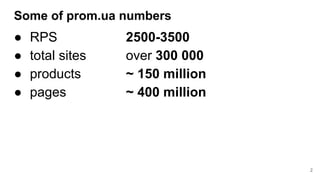
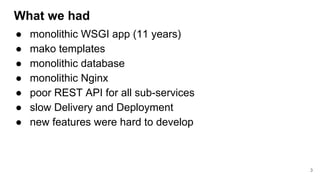
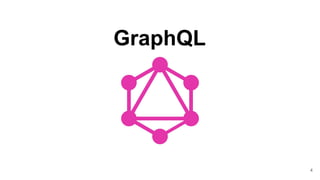



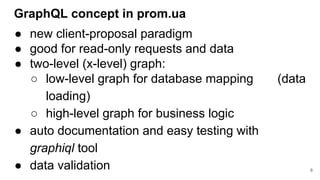



![from hiku.graph import Graph, Node, Link, Field, ...
from hiku.sources import sqlalchemy as sa
from hiku.types import Boolean, Integer, String, TypeRef, ...
product_query = sa.FieldsQuery('db.session', Product.__table__)
low_level_graph = Graph([
Node('Product', [
Field('id', Integer, product_query),
Field('name', String, product_query),
Field('price', None, product_query),
...
])
12](https://image.slidesharecdn.com/oleksandrtarasenko-pyconbelarus2019-190221150751/85/How-to-grow-GraphQL-and-remove-SQLAlchemy-and-REST-API-from-a-high-load-Python-project-Pycon-Belarus-2019-12-320.jpg)
![from hiku.graph import Graph, Node, Link, Field
from hiku.sources import sqlalchemy as sa
from hiku.types import Boolean, Integer, String, TypeRef
product_query = sa.FieldsQuery('db.session', Product.__table__)
low_level_graph = Graph([
Node('Product', [
Field('id', Integer, product_query),
Field('name', String, product_query),
Field('price', None, product_query),
...
])
13](https://image.slidesharecdn.com/oleksandrtarasenko-pyconbelarus2019-190221150751/85/How-to-grow-GraphQL-and-remove-SQLAlchemy-and-REST-API-from-a-high-load-Python-project-Pycon-Belarus-2019-13-320.jpg)
![from hiku.graph import Graph, Node, Link, Field
from hiku.sources import sqlalchemy as sa
from hiku.types import Boolean, Integer, String, TypeRef
product_query = sa.FieldsQuery('db.session', Product.__table__)
low_level_graph = Graph([
Node('Product', [
Field('id', Integer, product_query),
Field('name', String, product_query),
Field('price', None, product_query),
...
])
14](https://image.slidesharecdn.com/oleksandrtarasenko-pyconbelarus2019-190221150751/85/How-to-grow-GraphQL-and-remove-SQLAlchemy-and-REST-API-from-a-high-load-Python-project-Pycon-Belarus-2019-14-320.jpg)








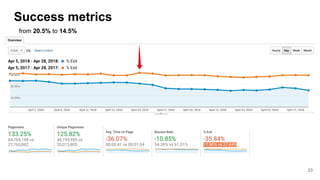




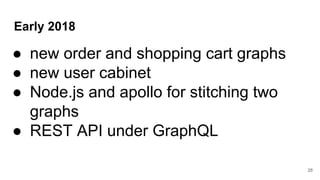




![product_query = sa.FieldsQuery('db.session', Product.__table__)
low_level_graph = Graph([
Node('Product', [
Field('id', Integer, product_query),
Field('name', String, product_query),
Field('price', None, product_query),
...
])
33](https://image.slidesharecdn.com/oleksandrtarasenko-pyconbelarus2019-190221150751/85/How-to-grow-GraphQL-and-remove-SQLAlchemy-and-REST-API-from-a-high-load-Python-project-Pycon-Belarus-2019-33-320.jpg)
![product_query = sa.FieldsQuery('db.session', Product.__table__)
low_level_graph = Graph([
Node('Product', [
Field('id', Integer, product_query),
Field('name', String, product_query),
Field('price', None, product_query),
...
])
34](https://image.slidesharecdn.com/oleksandrtarasenko-pyconbelarus2019-190221150751/85/How-to-grow-GraphQL-and-remove-SQLAlchemy-and-REST-API-from-a-high-load-Python-project-Pycon-Belarus-2019-34-320.jpg)
![product(ids: [1234, 1235]) {
id
name
price
}
"""
SELECT id, name, price FROM product
WHERE id IN (:id1, :id2, ..., :idN)
"""
35](https://image.slidesharecdn.com/oleksandrtarasenko-pyconbelarus2019-190221150751/85/How-to-grow-GraphQL-and-remove-SQLAlchemy-and-REST-API-from-a-high-load-Python-project-Pycon-Belarus-2019-35-320.jpg)
![product(ids: [1234, 1235]) {
id
name
price
}
"""
SELECT id, name, price FROM product
WHERE id IN (:id1, :id2, ..., :idN)
"""
36](https://image.slidesharecdn.com/oleksandrtarasenko-pyconbelarus2019-190221150751/85/How-to-grow-GraphQL-and-remove-SQLAlchemy-and-REST-API-from-a-high-load-Python-project-Pycon-Belarus-2019-36-320.jpg)
![low_level_graph = Graph([
Node('Product', [
Field('id', Integer, product_query),
...
Link(
'discount',
Optional[TypeRef['Discount']],
product_to_discount_query,
requires='id',
),
]),
Node('Discount', [
Field('id', Integer, discount_query),
Field('amount', Integer, discount_query),
])
])
37](https://image.slidesharecdn.com/oleksandrtarasenko-pyconbelarus2019-190221150751/85/How-to-grow-GraphQL-and-remove-SQLAlchemy-and-REST-API-from-a-high-load-Python-project-Pycon-Belarus-2019-37-320.jpg)
![low_level_graph = Graph([
Node('Product', [
Field('id', Integer, product_query),
...
Link(
'discount',
Optional[TypeRef['Discount']],
product_to_discount_query,
requires='id',
),
]),
Node('Discount', [
Field('id', Integer, discount_query),
Field('amount', Integer, discount_query),
])
])
38](https://image.slidesharecdn.com/oleksandrtarasenko-pyconbelarus2019-190221150751/85/How-to-grow-GraphQL-and-remove-SQLAlchemy-and-REST-API-from-a-high-load-Python-project-Pycon-Belarus-2019-38-320.jpg)
![low_level_graph = Graph([
Node('Product', [
Field('id', Integer, product_query),
...
Link(
'discount',
Optional[TypeRef['Discount']],
product_to_discount_query,
requires='id',
),
]),
Node('Discount', [
Field('id', Integer, discount_query),
Field('amount', Integer, discount_query),
])
])
39](https://image.slidesharecdn.com/oleksandrtarasenko-pyconbelarus2019-190221150751/85/How-to-grow-GraphQL-and-remove-SQLAlchemy-and-REST-API-from-a-high-load-Python-project-Pycon-Belarus-2019-39-320.jpg)


![42
product_sg = SubGraph(low_level_graph, 'Product')
high_level_graph = Graph([
Node('Product', [
Field('id', String, product_sg),
Field('name', String, product_sg.compile(S.this.name)),
Field('priceText', String, product_sg.compile(
get_price_text(S.this)
)),
Field('hasDiscount', Boolean, product_sg.compile(
is_discount_available(S.this, S.this.discount)
)),
Field('discountedPriceText', String, product_sg.compile(
get_discounted_price_text(S.this, S.this.discount)
)),
]),
])](https://image.slidesharecdn.com/oleksandrtarasenko-pyconbelarus2019-190221150751/85/How-to-grow-GraphQL-and-remove-SQLAlchemy-and-REST-API-from-a-high-load-Python-project-Pycon-Belarus-2019-42-320.jpg)
![43
product_sg = SubGraph(low_level_graph, 'Product')
high_level_graph = Graph([
Node('Product', [
Field('id', String, product_sg),
Field('name', String, product_sg.compile(S.this.name)),
Field('priceText', String, product_sg.compile(
get_price_text(S.this)
)),
Field('hasDiscount', Boolean, product_sg.compile(
is_discount_available(S.this, S.this.discount)
)),
Field('discountedPriceText', String, product_sg.compile(
get_discounted_price_text(S.this, S.this.discount)
)),
]),
])](https://image.slidesharecdn.com/oleksandrtarasenko-pyconbelarus2019-190221150751/85/How-to-grow-GraphQL-and-remove-SQLAlchemy-and-REST-API-from-a-high-load-Python-project-Pycon-Belarus-2019-43-320.jpg)
![44
product_sg = SubGraph(low_level_graph, 'Product')
high_level_graph = Graph([
Node('Product', [
Field('id', String, product_sg),
Field('name', String, product_sg.compile(S.this.name)),
Field('priceText', String, product_sg.compile(
get_price_text(S.this)
)),
Field('hasDiscount', Boolean, product_sg.compile(
is_discount_available(S.this, S.this.discount)
)),
Field('discountedPriceText', String, product_sg.compile(
get_discounted_price_text(S.this, S.this.discount)
)),
]),
])](https://image.slidesharecdn.com/oleksandrtarasenko-pyconbelarus2019-190221150751/85/How-to-grow-GraphQL-and-remove-SQLAlchemy-and-REST-API-from-a-high-load-Python-project-Pycon-Belarus-2019-44-320.jpg)
![45
@define(Record[{
'price': Float,
'price_currency_id': Integer,
'currency_settings': Any
}])
def get_price_text(product):
product_price_text = format_currency_data(
product_price,
product['price_currency_id'],
)
...
//..
return product_price_text.formatted_number](https://image.slidesharecdn.com/oleksandrtarasenko-pyconbelarus2019-190221150751/85/How-to-grow-GraphQL-and-remove-SQLAlchemy-and-REST-API-from-a-high-load-Python-project-Pycon-Belarus-2019-45-320.jpg)


![48
def link_to_some_product(opts):
product = db.session.query(
Product.id
).filter(
Product.id == opts['id'],
Product.status_on_display(),
).first()
if product is not None:
return product.id
else:
return Nothing](https://image.slidesharecdn.com/oleksandrtarasenko-pyconbelarus2019-190221150751/85/How-to-grow-GraphQL-and-remove-SQLAlchemy-and-REST-API-from-a-high-load-Python-project-Pycon-Belarus-2019-48-320.jpg)
![49
async def link_to_some_product(opts):
expr = select([Product.id]).where(
and_(
Product.id == opts['id'],
Product.status_on_display()
)
)
async with async_engine() as query_ctx:
product_id = await query_ctx.scalar(expr)
return product_id or Nothing](https://image.slidesharecdn.com/oleksandrtarasenko-pyconbelarus2019-190221150751/85/How-to-grow-GraphQL-and-remove-SQLAlchemy-and-REST-API-from-a-high-load-Python-project-Pycon-Belarus-2019-49-320.jpg)
![50
async def link_to_some_product(opts):
expr = select([Product.id]).where(
and_(
Product.id == opts['id'],
Product.status_on_display()
)
)
async with async_engine() as query_ctx:
product_id = await query_ctx.scalar(expr)
return product_id or Nothing](https://image.slidesharecdn.com/oleksandrtarasenko-pyconbelarus2019-190221150751/85/How-to-grow-GraphQL-and-remove-SQLAlchemy-and-REST-API-from-a-high-load-Python-project-Pycon-Belarus-2019-50-320.jpg)



![54
Example with aliases
def get_price_lists_data():
query = build([
Q.priceLists[
Q.id,
Q.name,
Q.file_id << Q.priceFileId,
Q.date_posted << Q.datePosted,
Q.url << Q.fileUrl,
]
])
graph_data = execute(query)
return graph_data.priceLists](https://image.slidesharecdn.com/oleksandrtarasenko-pyconbelarus2019-190221150751/85/How-to-grow-GraphQL-and-remove-SQLAlchemy-and-REST-API-from-a-high-load-Python-project-Pycon-Belarus-2019-54-320.jpg)
![55
Example with aliases
def get_price_lists_data():
query = build([
Q.priceLists[
Q.id,
Q.name,
Q.file_id << Q.priceFileId,
Q.date_posted << Q.datePosted,
Q.url << Q.fileUrl,
]
])
graph_data = execute(query)
return graph_data.priceLists](https://image.slidesharecdn.com/oleksandrtarasenko-pyconbelarus2019-190221150751/85/How-to-grow-GraphQL-and-remove-SQLAlchemy-and-REST-API-from-a-high-load-Python-project-Pycon-Belarus-2019-55-320.jpg)

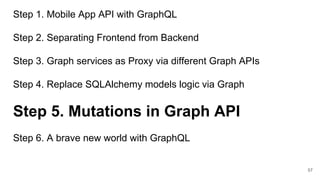

![mutation_graph = Graph(repr_graph.nodes + [
Root([
Link(
'addNewOpinion',
TypeRef['NewCommentResult'],
add_new_comment_for_opinion,
options=[
Option('opinion_id', Integer),
Option('comment', String),
], requires=None,
),
]),
])](https://image.slidesharecdn.com/oleksandrtarasenko-pyconbelarus2019-190221150751/85/How-to-grow-GraphQL-and-remove-SQLAlchemy-and-REST-API-from-a-high-load-Python-project-Pycon-Belarus-2019-59-320.jpg)
![mutation_graph = Graph(repr_graph.nodes + [
Root([
Link(
'addNewOpinion',
TypeRef['NewCommentResult'],
add_new_comment_for_opinion,
options=[
Option('opinion_id', Integer),
Option('comment', String),
], requires=None,
),
]),
])](https://image.slidesharecdn.com/oleksandrtarasenko-pyconbelarus2019-190221150751/85/How-to-grow-GraphQL-and-remove-SQLAlchemy-and-REST-API-from-a-high-load-Python-project-Pycon-Belarus-2019-60-320.jpg)
![def add_new_comment_for_opinion(ctx, options):
opinion_id = options['opinion_id']
comment = options['comment']
user = ctx['user']
opinion = Opinion.get(opinion_id)
...
form = OpinionCommentForm()
if not form.validate():
return NewCommentResult(id=None, errors=form.validate_resp())
comment = opinion.new_comment(...)
comment.message = clear_text(form.data['comment'])
comment.author_user_id = user.id
db.session.commit()
return NewCommentResult(id=comment.id, errors=[])](https://image.slidesharecdn.com/oleksandrtarasenko-pyconbelarus2019-190221150751/85/How-to-grow-GraphQL-and-remove-SQLAlchemy-and-REST-API-from-a-high-load-Python-project-Pycon-Belarus-2019-61-320.jpg)
![def add_new_comment_for_opinion(ctx, options):
opinion_id = options['opinion_id']
comment = options['comment']
user = ctx['user']
opinion = Opinion.get(opinion_id)
...
form = OpinionCommentForm()
if not form.validate():
return NewCommentResult(id=None, errors=form.validate_resp())
comment = opinion.new_comment(...)
comment.message = clear_text(form.data['comment'])
comment.author_user_id = user.id
db.session.commit()
return NewCommentResult(id=comment.id, errors=[])](https://image.slidesharecdn.com/oleksandrtarasenko-pyconbelarus2019-190221150751/85/How-to-grow-GraphQL-and-remove-SQLAlchemy-and-REST-API-from-a-high-load-Python-project-Pycon-Belarus-2019-62-320.jpg)
![def add_new_comment_for_opinion(ctx, options):
opinion_id = options['opinion_id']
comment = options['comment']
user = ctx['user']
opinion = Opinion.get(opinion_id)
...
form = OpinionCommentForm()
if not form.validate():
return NewCommentResult(id=None, errors=form.validate_resp())
comment = opinion.new_comment(...)
comment.message = clear_text(form.data['comment'])
comment.author_user_id = user.id
db.session.commit()
return NewCommentResult(id=comment.id, errors=[])](https://image.slidesharecdn.com/oleksandrtarasenko-pyconbelarus2019-190221150751/85/How-to-grow-GraphQL-and-remove-SQLAlchemy-and-REST-API-from-a-high-load-Python-project-Pycon-Belarus-2019-63-320.jpg)
![def add_new_comment_for_opinion(ctx, options):
opinion_id = options['opinion_id']
comment = options['comment']
user = ctx['user']
opinion = Opinion.get(opinion_id)
...
form = OpinionCommentForm()
if not form.validate():
return NewCommentResult(id=None, errors=form.validate_resp())
comment = opinion.new_comment(...)
comment.message = clear_text(form.data['comment'])
comment.author_user_id = user.id
db.session.commit()
return NewCommentResult(id=comment.id, errors=[])](https://image.slidesharecdn.com/oleksandrtarasenko-pyconbelarus2019-190221150751/85/How-to-grow-GraphQL-and-remove-SQLAlchemy-and-REST-API-from-a-high-load-Python-project-Pycon-Belarus-2019-64-320.jpg)




